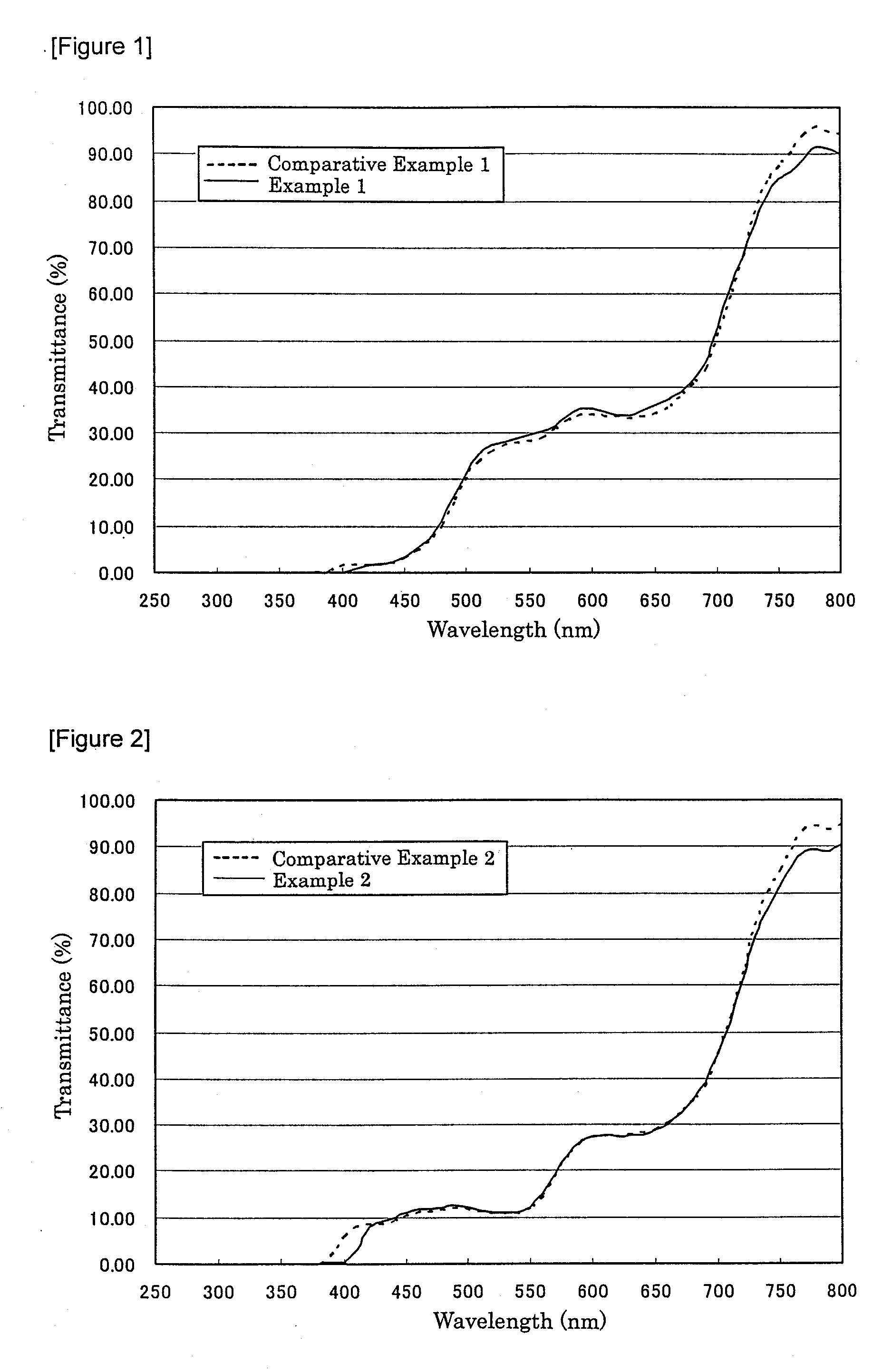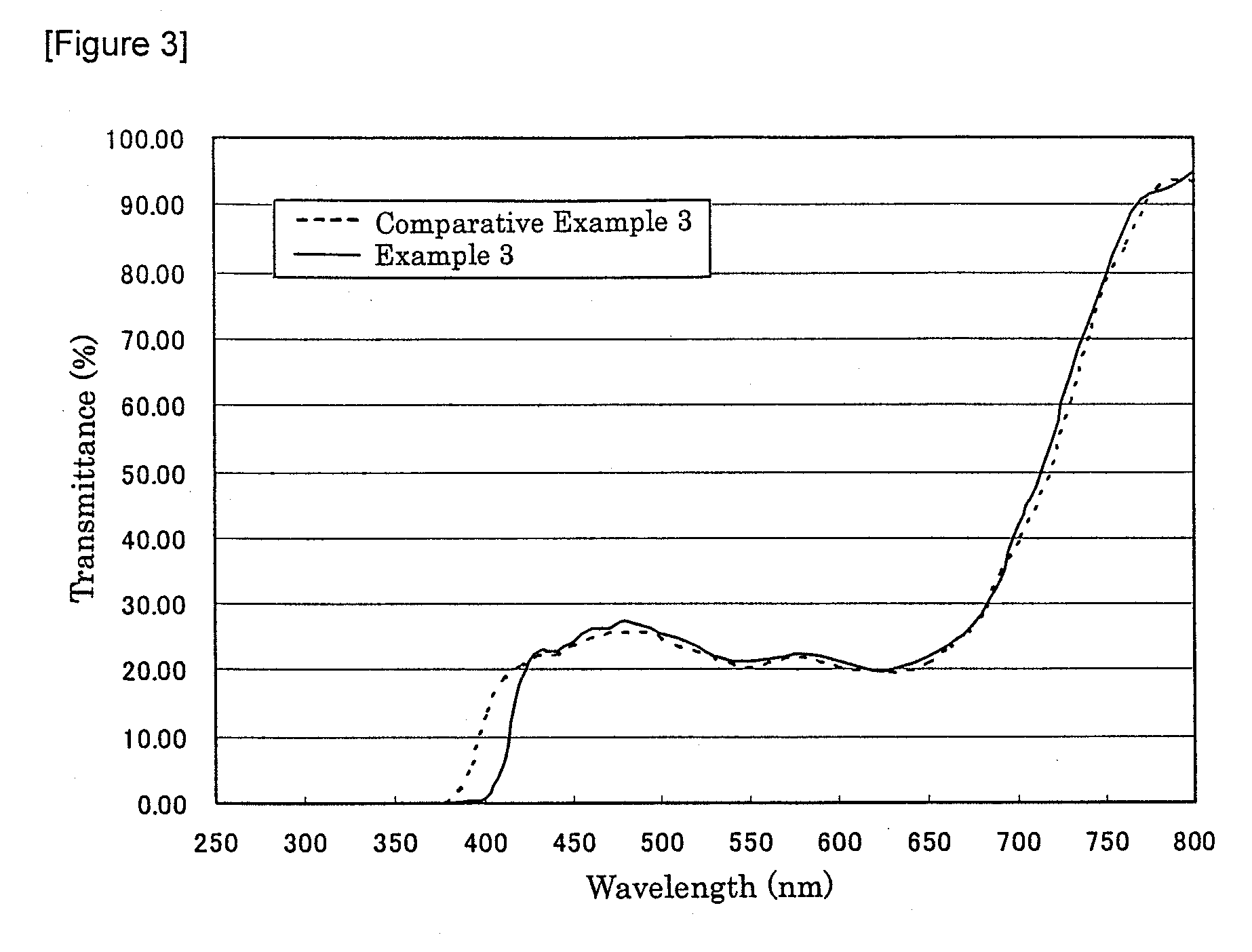Non-glaring laminated body, a coated non-glaring laminated body, a non-glaring material, and a method for producing the non-glaring material
a laminated body and non-glaring technology, applied in the direction of instruments, polarising elements, other domestic articles, etc., can solve the problem that no non-glaring material having an excellent property to cut ultraviolet rays up to long wavelength ultraviolet rays has been conventionally found, and achieves excellent polarizing properties, excellent appearance, and excellent cutting
- Summary
- Abstract
- Description
- Claims
- Application Information
AI Technical Summary
Benefits of technology
Problems solved by technology
Method used
Image
Examples
example 1
(a) Production of a Polarizing Film
[0118] Polyvinyl alcohol (manufactured by Kurare Co. Ltd., Trade name: VF-P#7500) was dyed at 35° C. for three minutes in an aqueous solution comprising 0.1 g / L of Sumilite Red 4B-P(C.I.28160), 0.78 g / L of Chrysophenine (C.I.24895), 0.3 g / L of Sumilite Supra Blue G (C.I.34200), and 10 g / L of anhydrous sodium sulfate, and then it was oriented by four-fold in the solution. This dyed film was immersed at 35° C. for three minutes in an aqueous solution comprising 2.5 g / L of nickel sulfate and 6.6 g / L of boric acid. The film was dried at room temperature for three minutes in its tense state, and then heat-treated at 110° C. for three minutes, to obtain a polarizing film. Its optical properties obtained were a transmittance corrected by visual sensitivity in all visible ranges T (vis.) of 29.9% and a degree of polarization R of 94.3%. The content of the nickel in the film was 1.2 mg / g. The content of the boric acid was 1.3 mg / g.
(b) Transparent Plastic...
example 2
(a) Production of a Polarizing Film
[0123] Polyvinyl alcohol (manufactured by Kurare Co. Ltd., Trade name: VF-P#7500) was dyed at 35° C. for three minutes in an aqueous solution comprising 1.83 g / L of Sumilite Red 4B-P(C.I.28160), 0.69 g / L of Chrysophenine (C.I.24895), 1.1 g / L of Sumilite Supra Blue G (C.I.34200), and 10 g / L of anhydrous sodium sulfate, and then it was oriented by four-fold in the solution. This dyed film was immersed at 35° C. for three minutes in an aqueous solution comprising 2.5 g / L of nickel sulfate and 6.6 g / L of boric acid. The film was dried at room temperature for three minutes in its tense state, and then heat-treated at 110° C. for three minutes to obtain a polarizing film. The optical properties of the polarizing film obtained were a transmittance corrected by visual sensitivity in all visible ranges T (vis.) of 19.0% and a degree of polarization P of 97.5%. The content of the nickel in the film was 1.2 mg / g. The content of the boric acid was 1.3 mg / g.
[...
example 3
(a) Production of a Polarizing Film
[0125] Polyvinyl alcohol (manufactured by Kurare Co. Ltd., Trade name: VF-P#7500) was dyed at 35° C. for three minutes in an aqueous solution comprising 0.37 g / L of Sumilite Red 4B-P(C.I.28160), 0.23 g / L of Chrysophenine (C.I.24895), 1.73 g / L of Sumilite Supra Blue G (C.I.34200), and 10 g / L of anhydrous sodium sulfate, and then it was oriented by four-fold in the solution. This dyed film was immersed at 35° C. for three minutes in an aqueous solution comprising 2.5 g / L of nickel sulfate and 6.6 g / L of boric acid. The film was dried at room temperature for three minutes in its tense state, and then heat-treated at 110° C. for three minutes to obtain a polarizing film.
[0126] The optical properties of the polarizing film obtained were a transmittance corrected by visual sensitivity in all visible ranges T (vis.) of 19.8% and a degree of polarization P of 99.8%. The content of the nickel in the film was 1.2 mg / g and the content of the boric acid was ...
PUM
| Property | Measurement | Unit |
|---|---|---|
| thick | aaaaa | aaaaa |
| temperature | aaaaa | aaaaa |
| concentration | aaaaa | aaaaa |
Abstract
Description
Claims
Application Information
 Login to View More
Login to View More - R&D
- Intellectual Property
- Life Sciences
- Materials
- Tech Scout
- Unparalleled Data Quality
- Higher Quality Content
- 60% Fewer Hallucinations
Browse by: Latest US Patents, China's latest patents, Technical Efficacy Thesaurus, Application Domain, Technology Topic, Popular Technical Reports.
© 2025 PatSnap. All rights reserved.Legal|Privacy policy|Modern Slavery Act Transparency Statement|Sitemap|About US| Contact US: help@patsnap.com


